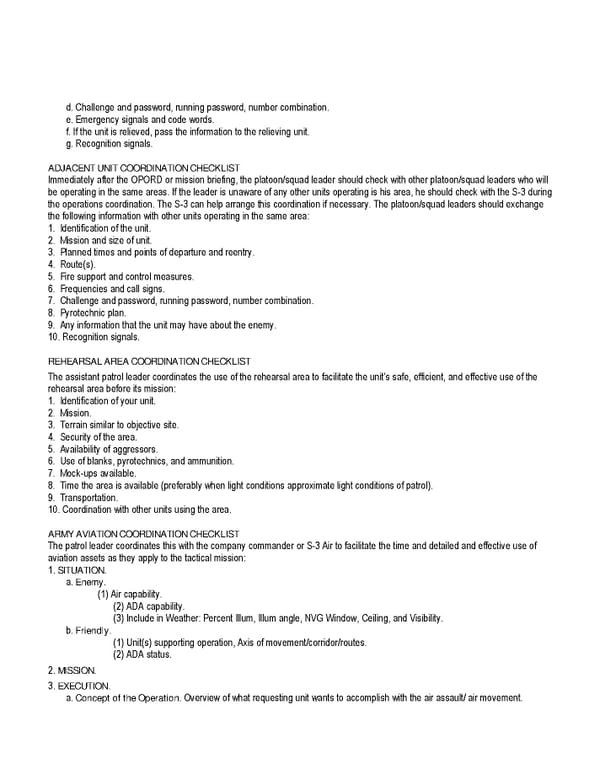d. Challenge and password, running password, number combination. e. Emergency signals and code words. f. If the unit is relieved, pass the information to the relieving unit. g. Recognition signals. ADJACENT UNIT COORDINATION CHECKLIST Immediately after the OPORD or mission briefing, the platoon/squad leader should check with other platoon/squad leaders who will be operating in the same areas. If the leader is unaware of any other units operating is his area, he should check with the S-3 during the operations coordination. The S-3 can help arrange this coordination if necessary. The platoon/squad leaders should exchange the following information with other units operating in the same area: 1. Identification of the unit. 2. Mission and size of unit. 3. Planned times and points of departure and reentry. 4. Route(s). 5. Fire support and control measures. 6. Frequencies and call signs. 7. Challenge and password, running password, number combination. 8. Pyrotechnic plan. 9. Any information that the unit may have about the enemy. 10. Recognition signals. REHEARSAL AREA COORDINATION CHECKLIST The assistant patrol leader coordinates the use of the rehearsal area to facilitate the unit’s safe, efficient, and effective use of the rehearsal area before its mission: 1. Identification of your unit. 2. Mission. 3. Terrain similar to objective site. 4. Security of the area. 5. Availability of aggressors. 6. Use of blanks, pyrotechnics, and ammunition. 7. Mock-ups available. 8. Time the area is available (preferably when light conditions approximate light conditions of patrol). 9. Transportation. 10. Coordination with other units using the area. ARMY AVIATION COORDINATION CHECKLIST The patrol leader coordinates this with the company commander or S-3 Air to facilitate the time and detailed and effective use of aviation assets as they apply to the tactical mission: 1. SITUATION. a. Enemy. (1) Air capability. (2) ADA capability. (3) Include in Weather: Percent Illum, Illum angle, NVG Window, Ceiling, and Visibility. b. Friendly. (1) Unit(s) supporting operation, Axis of movement/corridor/routes. (2) ADA status. 2. MISSION. 3. EXECUTION. a. Concept of the Operation. Overview of what requesting unit wants to accomplish with the air assault/ air movement.
 Ranger Handbook Page 47 Page 49
Ranger Handbook Page 47 Page 49